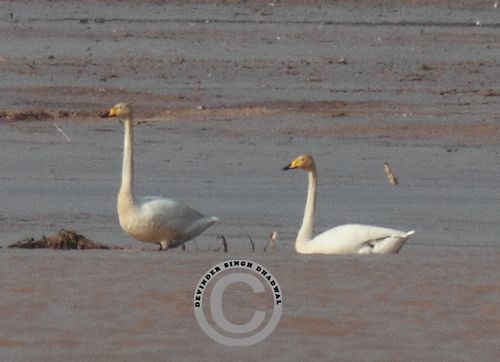Pong Wetland (Himachal Pradesh): The Whooper (pronounced hooper) swan, a long distance migratory bird from subarctic Eurasia has been sighted and photographed at the Pong lake by Devinder Singh Dhadwal, an Assistant Conservator of Forests and accomplished ornithologist, on Tuesday, 29th Jan 2013.
The last record of this bird, shot on the river Beas is by EH Aitken in 1900. The Whooper swan was earlier recorded in Notes on the Swans of India by AO Hume in 1878.
Like Sauras cranes, the Whooper Swans are known to pair for life

The reappearance of this swan on the Beas at the Pong wetland after more than a century bodes well for this Ramsar site as a growing favourite among migratory birds over the years.
This is the 418th bird species to be recorded at the Pong lake; a significant number considering that the entire known bird diversity for the Indian sub-continent is around 1250 species.
The Whooper swan is one of the heaviest flying birds with an average body weight of 9.8–11.4 kg for males and 8.2–9.2 kg for females.
Because their weight cannot be supported by their legs for long periods, they require large bodies of water and spend much of their time swimming and feeding.
The sighting of a pair of Whooper Swans at Pong in the run up to the annual bird count being conducted at the wetland on January 31 and February 1, is being viewed as a “reward” for Devindra Dhadwal who has spent years as Range Officer here and with painstaking research been able to publish a detailed photographic book titled Wild Wings – Pong and its Birds in 2011.
Incidentally, the Whooper Swan is the national bird of Finland and is featured on the Finnish 1 Euro coin.
Photo by Devinder Singh Dhadwal
Nodnat – is a pen name that the writer with deep knowledge of Himalayan flora and fauna and a keen environmentalist has adopted. He hails from Kotgarh, in Shimla Hills and retired as Principal Chief Conservator of Forests from Himachal Pradesh forest department.


Kudos D. Dhadwal! This news is another feather in your cap as an accomplished ornithologist. Why don’t you think another book on birds. Congrats!!!
Mr Frank Finn, Deputy Superintendent of the Indian Museum, in his book on Water Fowl of India and Asia, written in 1909 has also illustrated on Whooper Swan at page nos 10-11 as follows:
The Whooper is a more northern species than the
Mute Swan, breeding in high latitudes in Europe and
Asia, and wintering in the greater part of the former
Continent, and in the temperate regions of the latter.
It has only thrice been found in India. Hodgson obtained
a specimen in the Nepal Valley in January 1829.
This, or rather its skull and foot, had been referred by
Mr. Hume to the smaller species Cygnus hewicki ; but
Blanford regarded the relics as undoubtedly pertaining
to a Whooper. No other specimen as was recorded
till 1900, when Lieutenant-General W. Osborn, i.s.c,
shot one out of a flock of four on the River Beas on
January 6th. Also, on January 31st, 1904, Mr. J.
Crerar shot one on the Changra Dhand in Sind.
Pl go through the following article appeared in Dec 2010 National Geographic issue:
The whooper swan is a bird to inspire flights of fancy.
By Cathy Newman
From the swirl of its initial letter to its sighing vowel and feather-soft final consonant, the very word—”swan”—suggests grace. Peter Ilich Tchaikovsky did not, after all, write Duck Pond. The whooper swan, like its onomatopoeic cousins, the whistling and the trumpeter, belongs to an elegant society of sisters; the mute, Bewick’s, black, and black-necked fill out the ranks. First described by Carl Linnaeus in 1758, Cygnus cygnus can be considered a swan among swans, the type species, hence archetype, of all swans. It is also a swan of superlatives. With a population of about 180,000, the whooper, though vulnerable to loss of habitat, is among the most abundant of swans and trumps others in the sweep of its range.
To the ancients, the appearance of a swan, with its effortless glide on the mirror of a lake and lovely, unfurling flight, signaled evanescence and evoked immortal longings. Socrates, Plato tells us, heard the song of a swan on the day of his death. The Valkyries, in the guise of swans, bore their fallen heroes to the Valhalla of Norse mythology. Pythagoras believed the souls of poets passed into swans, a fitting entombment that turns the tattered phrase “poetry in motion” into a truly lyrical trope.
The swan, Russian poet Anna Akhmatova writes, “floats through the centuries” and into the turning wheel of seasons. Swans on their autumnal migratory flight—the celestial flutter of wings, the silver arrow of a flock splitting the sky—evoke poetic melancholy. Shadows lengthen. Days shorten. Another year closes in. Still, there is the reassuring uplift of fairy tales like Hans Christian Andersen’s duckling turned swan, with its metamorphosis from plain to princely.
Bittersweet, these beautiful birds. Yet their loveliness masks the toll exacted by the gravitational pull of their large bodies and the strain of daily survival. Labored takeoffs, the frantic paddling of webbed feet and heavy beating of wings before their soaring ascent, a territorial aggressiveness directed at other swans and waterfowl that can turn vicious and, occasionally, deadly, suggest that beauty does not come as easily or kindly as we might wish.